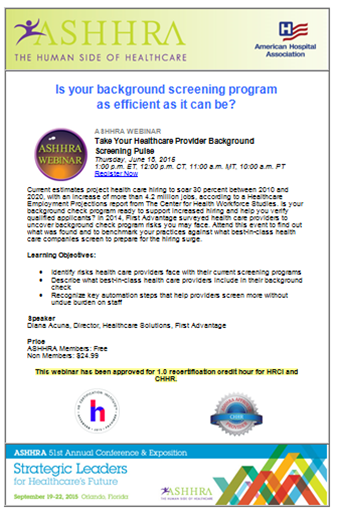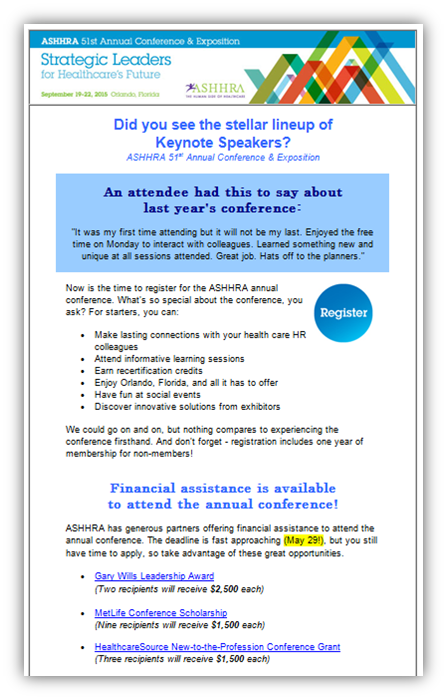Email Marketing: Finding a Frequency that is Just Right

Do you remember the story of Goldilocks and the Three Bears?
Goldilocks, the intrepid young girl, stumbles across the Three Bears’ home in the woods, and spends the rest of her day trying out their porridge, their chairs and even their beds. Every time, the first two items she tries are never quite right for her. But her third choice always suits her just right, and poor Baby Bear ends up with no porridge, a broken chair and a bed with a stranger in it.
Goldilocks’ poor manners aside, association executives can learn from her relentless experimenting when it comes to email marketing. Whether your association is examining regular informational emails you already send to members and other stakeholders, or you’re ready to start an email campaign, a common question is, “How often should we email our members?”
The best answer for your association will come from testing different “send” frequencies and examining the response you receive. Consider these five factors that impact how often members will want to hear from your association via email:
![]()
There’s no magic formula for the right email frequency. You must test, experiment, measure and test some more.
Number of emails, length, relevancy, timing and action requirements of your emails all determine how often you should email members.
Don’t burden members with too many call-to-action emails. Mix it up with purely informational.
- The total number of emails you send. How much information do you need to pass along to members and other stakeholders? How often will they tolerate hearing from you? The answer will be different for every association based on the sum of your programming, educational activities, advocacy efforts and other operations.

During a recent webinar that Kelly Clark, manager for online marketing with Naylor Association Solutions hosted with Ferdinand Libunao, marketing & communications manager for the American Society for Healthcare Human Resources Administration, Libunao said ASHHRA’s board and communications committee researched open and click rates for different emails that ASHHRA sent to members over a period of years to determine how frequently they should contact members. ASHHRA is a large organization with many publications and information pieces, but its staff smartly realized that bombarding members with daily emails would probably not go over well with members.

“Three [emails] per week is what we ultimately decided on,” Libunao said. “Every year, we ask our membership to tell us in our membership survey if we communicate too much or too little. We have not had to change our sending strategy because our frequency was based in research in the first place.”
Consolidating information into a small number of emails as ASHHRA does gives your association room to send ad hoc, urgent information when needed without annoying your recipients.

If you don’t have a long history of email reports, take a cue from Goldilocks and test a few email frequencies over a period of a few months. Examine the resulting engagement with your emails during each distinct frequency schedule and settle on the frequency that sees the most engagement.
Finally, the total number of emails you send is going to depend on how often your content changes. If you usually have the same basic message – “Join us for our monthly luncheon” or “Here’s what’s going on this month” – you don’t need to send as many emails. You’ll be seen as redundant. But if your association constantly has fresh news to report, a daily digest may work well (or even be expected) for your membership.
- The length of your association’s emails. If you have a very basic message, keep your emails short. People skim emails and do not have patience for wordiness. Get your point across quickly, and readers will be receptive to hearing from you more often.
If your emails contain information that requires more thought and planning – a notice about how to renew membership at different levels, or final instructions for people attending your event – you can write a longer email and maintain the same frequency. People skim, but they also pay close attention when they see an email with important information.
Consider incorporating these elements into your emails to help keep them short but interesting:
- Break your content into parts and send a series of related emails. Include language that sets up the series: “Inside: Study Tip #1 of 3 For Your Upcoming Certification Exam.”
- Use images to describe the value of your products or services.
- Use plenty of white space around text and images. This makes your emails easier to scan and makes them more mobile-friendly.

- How often your association asks the recipient to take action. If your association sends an email that asks the recipient to complete an action every time, your recipients will quickly tire of your emails because you’ll come off as too demanding. Send a mix of purely informational and action-oriented emails so that your marketing schedule can support more emails. Keep in mind, however, that some calls to action require repetition to be heard.

- How relevant the email is right now. Send emails when it’s appropriate. Are you emailing about an event that doesn’t take place for another 10 months? Sending information about it a couple times per month would likely be well-received, but emailing members about it every day will be seen as overkill. The relevance of the information relative to what’s going on in your members’ world right now determines how often you should be emailing them about it.

“We frequently hold webinars, and for those events, we like to make email into a digest,” said Libunao. “Let’s say that we have three coming up in the next two weeks. Since they are all education based, we will make that email an education email. Though there are three webinars in the email, there is still only one focus: education. The members receive information about three events but only one email,” he said.
- The timing of your emails. People sometimes tolerate more emails if they come on a certain day, or at a certain time of day. Setting an expectation for when members will hear from you via email, whether clearly stated on an email subscription form or made known through consistent scheduling, can result in members interacting with your email marketing program more favorably.
Determine the best frequency to send emails through A/B testing. Send your emails to one half of your list on one day, and to the other half on another day. Experiment with the best time to send emails by sending to half your list in the morning, and the other half later in the day. Keep a master calendar of all your tests, and record open rates, click rates and unsubscribe rates to pinpoint which day and time of the week yields the most interaction.
Testing can also show you when to send emails based on your desired interaction. One client of ours tested sending emails during the week versus sending them on the weekend. They discovered that emails sent during the week yielded higher open rates, but sending emails on the weekend resulted in a higher click-to-open rate. Now, when they send an information email that doesn’t have a call to action, they send it on a weekday. But if they want recipients to act on an email, they send it on Saturday. When testing emails, remember to experiment with one variable at a time.
The frequency of your association’s emails will depend on the amount of content you have to share, and how long you decide to make your emails. Your association should consider how often you ask recipients to take action from an email and how relevant the information inside is to a member’s job and life at the moment. Finally, your email frequency should be determined by data. Look at your email reports for a strong idea of how often your recipients open and interact with your emails, and thus how often your association is welcome in their inbox.
Finding the right email frequency can feel a lot like Goldilocks’s story: sometimes the complaints tell you you’re emailing too much, and sometimes the lack of response tells you you’re emailing too little. But with practice, testing and measurement, your association is sure to find an email frequency that is just right.

